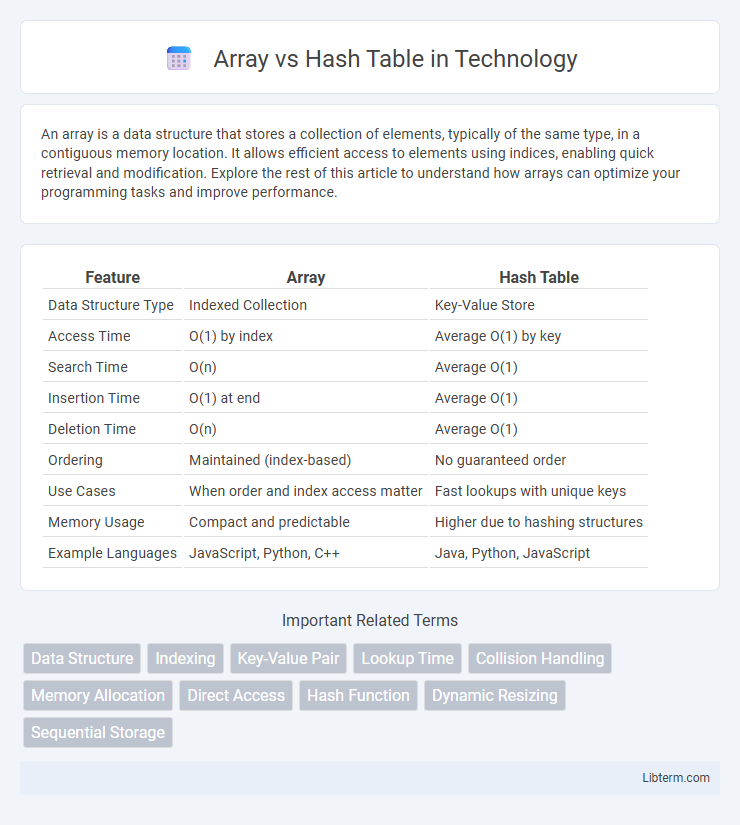An array is a data structure that stores a collection of elements, typically of the same type, in a contiguous memory location. It allows efficient access to elements using indices, enabling quick retrieval and modification. Explore the rest of this article to understand how arrays can optimize your programming tasks and improve performance.
Table of Comparison
| Feature | Array | Hash Table |
|---|---|---|
| Data Structure Type | Indexed Collection | Key-Value Store |
| Access Time | O(1) by index | Average O(1) by key |
| Search Time | O(n) | Average O(1) |
| Insertion Time | O(1) at end | Average O(1) |
| Deletion Time | O(n) | Average O(1) |
| Ordering | Maintained (index-based) | No guaranteed order |
| Use Cases | When order and index access matter | Fast lookups with unique keys |
| Memory Usage | Compact and predictable | Higher due to hashing structures |
| Example Languages | JavaScript, Python, C++ | Java, Python, JavaScript |
Introduction to Arrays and Hash Tables
Arrays are linear data structures that store elements in contiguous memory locations, allowing efficient index-based access with constant time complexity, O(1). Hash tables organize data using a hash function to map keys to specific indices, enabling average-case constant time complexity for search, insert, and delete operations. While arrays excel at ordered data storage and quick access by position, hash tables provide faster lookup for key-value associations without maintaining order.
Core Concepts: Definitions and Structures
An array is a linear data structure consisting of elements identified by index positions, offering fast access through contiguous memory allocation. A hash table is a data structure that stores key-value pairs, using a hash function to compute an index that points to where the value is stored, enabling efficient average-case retrievals. Arrays provide constant-time access via indices but lack built-in support for key-based lookup, whereas hash tables optimize for associative access and handle collisions through techniques like chaining or open addressing.
Data Storage and Organization
Arrays organize data in contiguous memory locations, enabling fast index-based access with O(1) time complexity. Hash tables store data using key-value pairs and utilize a hash function to map keys to buckets, providing average O(1) lookup time but with potential collisions handled via chaining or open addressing. While arrays excel in ordered data storage and predictable access patterns, hash tables offer flexible, efficient data retrieval for unordered collections with dynamic key sets.
Access and Retrieval Efficiency
Arrays provide constant-time access (O(1)) to elements via index, making them highly efficient for sequential data storage and retrieval when the index is known. Hash tables offer average-case constant-time complexity (O(1)) for access and retrieval based on keys, using a hash function to map keys to indices, but performance may degrade to O(n) in case of collisions or poor hash functions. Despite their quick access, hash tables require extra memory for storing keys and values, whereas arrays are more memory-efficient due to contiguous memory allocation.
Insertion and Deletion Operations
Array insertion and deletion operations typically have a time complexity of O(n) due to the need for shifting elements, especially when modifying positions other than the end. Hash table insertion and deletion generally achieve average time complexity of O(1) by utilizing hash functions for direct indexing, though worst-case scenarios can degrade to O(n) due to collisions. Arrays provide efficient access but slower modification, while hash tables offer fast dynamic updates at the cost of potential hashing overhead and memory use.
Memory Usage and Allocation
Arrays allocate a contiguous block of memory, leading to efficient memory usage and fast access times with fixed size determined at initialization. Hash tables use more memory due to storing key-value pairs along with additional space for handling collisions, often requiring dynamic resizing that impacts allocation overhead. Memory allocation in arrays is predictable and minimal, whereas hash tables demand extra memory buffers and periodic resizing operations to maintain performance.
Use Cases and Applications
Arrays excel in scenarios requiring indexed data storage with fast access times, such as implementing static lists, buffers, and matrices in applications like multimedia processing and numerical computations. Hash tables support efficient key-value pair management, making them ideal for dynamic data lookups, dictionaries, caching, and database indexing where quick insertion and retrieval by unique keys are essential. Choosing between arrays and hash tables depends on whether fixed-size sequential access or flexible, rapid key-based access is crucial for the specific application context.
Performance Comparison: Time and Space Complexity
Arrays offer constant time complexity O(1) for element access due to contiguous memory allocation, making them highly efficient for indexed data retrieval, but they require O(n) time for search operations. Hash tables provide average-case constant time complexity O(1) for search, insert, and delete operations through hashing, though worst-case time complexity can degrade to O(n) in case of collisions. Space complexity for arrays is O(n) with a fixed size, while hash tables typically consume more space O(n + m) to accommodate load factors and reduce collisions, impacting memory overhead.
Limitations and Drawbacks
Arrays have fixed sizes, limiting dynamic data storage and requiring costly resizing operations, which impacts performance. Hash tables, while providing average constant-time complexity for lookups, suffer from collisions that degrade performance to linear time and require extra memory for maintaining buckets or chains. Both data structures lack efficient support for ordered data retrieval, with arrays offering slow searches without sorting and hash tables inherently unordered.
Choosing Between Array and Hash Table
Choosing between an array and a hash table depends on data access and storage needs; arrays offer efficient indexed access with constant-time retrieval when the index is known, while hash tables provide faster lookups for associative data through key-value pairs with average constant-time complexity. Arrays are ideal for fixed-size collections or when order matters, whereas hash tables excel in dynamic datasets requiring frequent insertions, deletions, and quick key-based searches. Understanding your application's need for ordered data versus rapid key lookup is crucial in selecting the right data structure.
Array Infographic

 libterm.com
libterm.com